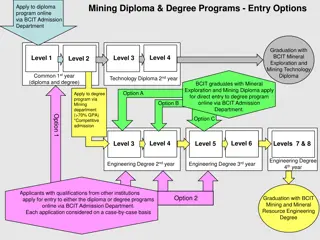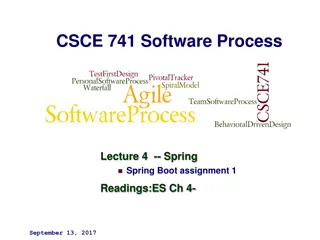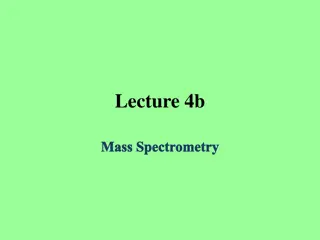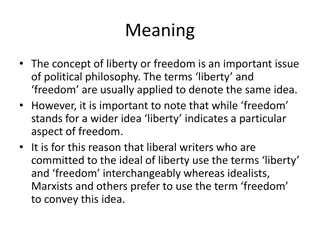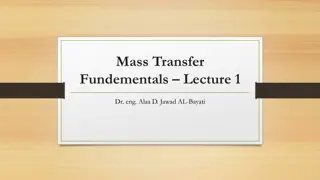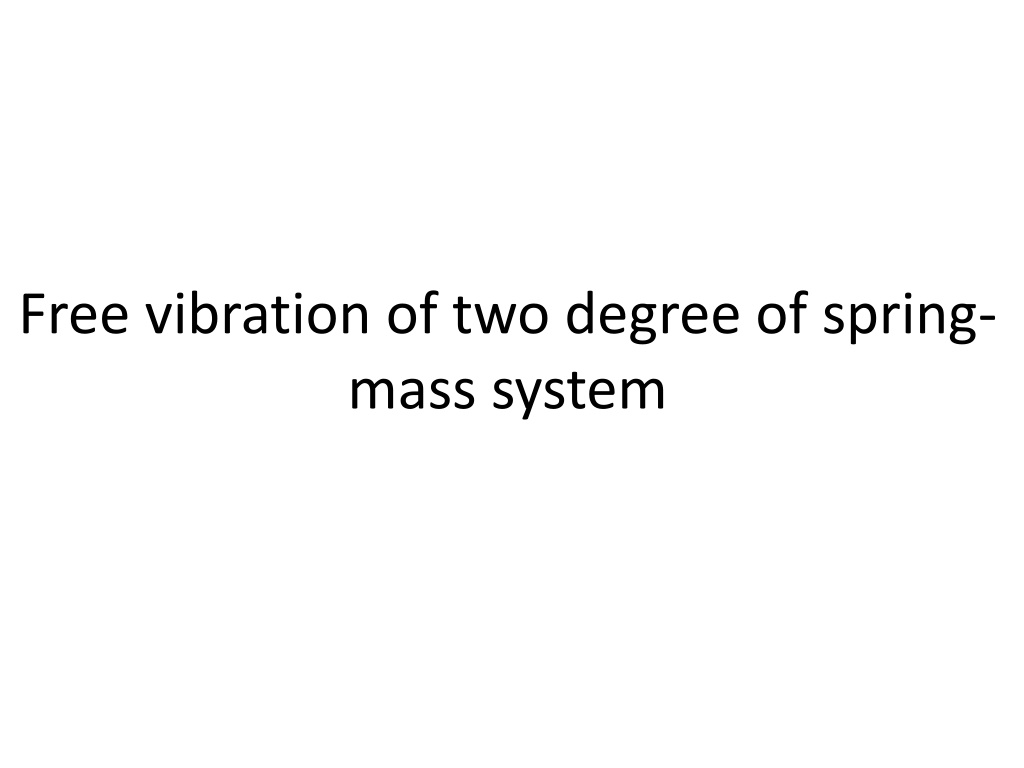
Understanding Two-Degree Spring-Mass System Vibration
Delve into the free vibration analysis of a two-degree spring-mass system, exploring natural frequencies, mode shapes, derivation of motion equations, free body diagram insights, and matrix representations for mass and stiffness properties, aiding in understanding dynamic behavior of mechanical systems.
Download Presentation

Please find below an Image/Link to download the presentation.
The content on the website is provided AS IS for your information and personal use only. It may not be sold, licensed, or shared on other websites without obtaining consent from the author. Download presentation by click this link. If you encounter any issues during the download, it is possible that the publisher has removed the file from their server.
E N D
Presentation Transcript
Free vibration of two degree of spring- mass system
Outline 1. Two degree of freedom spring mass system 2. Two natural frequencies of 2-DOF spring mass system 3. Two mode shape of 2-DOF spring mass system 4. Mass matrix and Stiffness matrix. 5. Orthogonality properties of mass matrix and Stiffness matrix. 6. Eigen vectors and Eigen values.
Derive the differential equation of motion of two degree of freedom spring mass system. Mass -1 Mass -2 1. No of degree of freedom = 2 2. Degree of freedom are displacement of mass-1 (x1) and displacement of mass-2 (x2)
Draw free body diagram Assume x2 > x1 FBD of mass-1 k * x1 k * (x2 x1 ) Spring -1 Spring -3 Spring -2 Assume x2 > x1 o Length of spring -1 increase by x1 FBD of mass-2 o Length of spring -2 increase by x2 x1 o Length of spring -3 decrease by x2 . k * (x2 x1 ) k * x2
Draw free body diagram FBD of mass-2 FBD of mass-1 k * x1 k * (x2 x1 ) k * (x2 x1 ) k * x2 Apply Newton s second law of motion. Apply Newton s second law of motion. Mass * acceleration = resultant of force Mass * acceleration = resultant of force 1 = acceleration of mass -1 in horizontal direction 2 = acceleration of mass -2 in horizontal direction m 1 = k * (x2 x1 ) - k * x1 m 2 = - k * (x2 x1 ) -k * x2 m 1 - k * (x2 x1 ) + k * x1 = 0 m 2 + k * (x2 x1 ) + k * x2 = 0 m 1 + 2k x1 - k x2 = 0 m 2 - k x1 + 2k x2 = 0
Matrix representation m 1 + 2k x1 - k x2 = 0 Equation - 1 Equation - 2 m 2 - k x1 + 2k x2 = 0 Stiffness matrix [K] Equation - 1 m11 Equation - 1 k12 k11 m12 m 1 + 0 2 + 2k x1 - k x2 = 0 m 1 + 0 2 + 2k x1 - k x2 = 0 Equation - 2 m21 Equation - 2 k22 m22 k21 0 1 + m 2 - k x1 + 2k x2 = 0 0 1 + m 2 - k x1 + 2k x2 = 0 Mass matrix [M] Stiffness matrix [K] m11 m21 m12 m22 k11 k21 k12 k22 ? = ? = ? ? ? ? 2k k k 2k ? = ? =
Natural frequencies Det ( K 2 M ) = 0 k12 k22- 2m11 m12 m22 K 2 M = k11 m21 k21 K = Stiffness matrix k12 k22- 2m11 2m12 2m22 K 2 M = k11 M = Mass matrix 2m21 k21 = natural frequency K 2 M = k11 2m11 k12 2m21 k22 2m22 Det = determinate of matrix k21 2m21 Det ( K 2 M ) = 0 k11 k21 k12 k22 ? = k11 2m11 k21 2m21 k12 2m21 k22 2m22 = 0 m11 m21 m12 m22 ? = 2? = 2m11 m12 m22 m21
Natural frequencies ? ? ? ? Mass -1 Mass -2 ? = 2k k k 2k ? = Natural frequencies Det ( K 2 M ) = 0 2k ? 2 k k = 0 k 2k 2 ? ? ? K 2 M = 2k 2k ? 2 ? k k 2k ? 2 ? K 2 M = 2k (2k ? 2)*(2k ? 2) ( k)( k) = 0 ? 2 ? k K 2 M = 2k ? 2 k m2 4- 4km 2 + 3k2 = 0 2k ? 2 k Solve this equation.
Mode Shape k A1 A2 m 1 + 2k x1 - k x2 = 0 = Equation-1 2k -m 2 m 2 - k x1 + 2k x2 = 0 Assume solution of above equation is, x1 = A1Sin( t + ) m 2 - k x1 + 2k x2 = 0 x2 = A2Sin( t + ) 1 = - 2A1Sin( t + ) -m 2A2Sin( t + )- k A1Sin( t + ) 2 = - 2A2Sin( t + ) + 2k A2Sin( t + ) = 0 Substitute in above equation we get, - k A1 + (2k -m 2) A2 = 0 m 2A1Sin( t + ) + 2k A1Sin( t + ) - k A2Sin( t + ) = 0 - 2k -m 2 k A1 A2 Equation-2 = { ( 2k - m 2 ) A1 - k A2 } Sin( t + ) = 0 ( 2k - m 2 ) A1 - k A2 = 0
Mode Shape k 2 = k A1 A2 m = Equation-1 2k -m 2 k = m 2k -m 2 k A1 A2 Equation-2 = Case-2: 2k -m 2 < 0 2k -m 2 = - k Equate equation-1 and 2, m 2 = 3k 3k 2 = k 2k -m 2 k m = 2k -m 2 3k = m (2k -m 2 ) 2 = k2 Smallest of these two is called as first natural frequency and largest is called second natural frequency Case-1: 2k -m 2 > 0 k 3k m m 2k -m 2 = k 1 = first natural frequency 2= second natural frequency m 2 = k 1 2
First mode Shape k 2k -m 2 k A1 A2 A1 A2 = Equation-1 Equation-2 = 2k -m 2 First mode shape First mode shape = 1 = 1 k A11 A21 = k 2k -m 2 k k A1 A2 12 = 12 = = m 2k -m ( 1) 2 m k A11 A21 = 2k -k A1 A2 2k - k = k k A11 A21 = k A11 A21= k k A11 A21 = A11 A21= 1 First mode shape 1 First mode shape
Second mode Shape k 2k -m 2 k A1 A2 A1 A2 = Equation-1 Equation-2 = 2k -m 2 First mode shape First mode shape = 2 = 1 k A12 A22 3k 2k -m 22 k 3k A12 A22 = 22 = = 22 = m 2k -m ( 2) 2 m k A12 A22 = 2k -3k A12 A22= 2k - 3k k k A12 A22 = -k A12 A22= -k k A12 A22 = A12 A22= -1 Second mode shape -1 Second mode shape
Mode shape plot First mode shape plot Second mode shape plot +1 A12 A11 A21 A22 Node - 1 o Both masses are in phase. o Both masses are out of phase.
Node The point which vibrate with zero amplitude i.e. The stationary point is called node. A12 A22 Node
1. Two natural frequencies of 2-DOF spring mass system x1 x2 3*x2 1*(x2 x1 ) 10 *x1 1*(x2 x1 )
1. Two natural frequencies of 2-DOF spring mass system 3*x2 1*(x2 x1 ) 1*(x2 x1 ) 10 *x1 150* 1 = 1000(x2 x1 ) - 10 000*x1 50* 2 = - 1000(x2 x1 ) - 3 000*x2 150* 1 + 11000x1 - 1000*x2 = 0 50* 2 - 1000 x1 + 4000 x2 = 0 150* 1 + 0* 2 + 11000x1 - 1000*x2 = 0 0* 1 + 50* 2 - 1000 x1 + 4000 x2 = 0 150 0 0 50 11000 1000 1000 4000 ? = ? =
Natural frequencies 150 0 0 50 11000 1000 1000 4000 ? = ? = Natural frequencies Det ( K 2 M ) = 0 K 2 M = 11000 1000 4000 2 150 0 50 1000 0 11000 ??? 2 1000 1000 4000 ?0 2 = 0
Solution: Due to force F, Spring -1 stretched at amount of x. Spring-2 compressed at an amount of x. FBD at node at which force F apply, F1 F F2 Spring is in parallel. Since deflection in spring is same. F1 = Spring force due to spring-1 = k x Potential energy stored in spring-1 F2 = Spring force due to spring-2 U1 = (1/2) * stiffness constant * = k x (extension or compression on spring )2 Force equilibrium equation F = F1 + F2 U1 = (1/2) * k * x2
Query: Deflection in both spring is same and why take combined effect of force to find deflection in spring 1st for calculation of stored strain energy in 1st spring. Solution: Due to force F, Spring -1 stretched at amount of x. Spring-2 compressed at an amount of x. FBD at node at which force F apply, F1 F F2 Spring is in parallel. Since deflection in spring is same. F1 = Spring force due to spring-1 = k x Potential energy stored in spring-1 F2 = Spring force due to spring-2 U1 = (1/2) * stiffness constant * = k x (extension or compression on spring )2 Force equilibrium equation F = F1 + F2 U1 = (1/2) * k * x2
Query: Deflection in both spring is same and why take combined effect of force to find deflection in spring 1st for calculation of stored strain energy in 1st spring. Solution: Due to force F, Spring -1 stretched at amount of x. Spring-2 compressed at an amount of x. FBD at node at which force F apply, F1 F F2 Spring is in parallel. Since deflection in spring is same. F1 = Spring force due to spring-1 = k x Potential energy stored in spring-1 F2 = Spring force due to spring-2 U1 = (1/2) * stiffness constant * = k x (extension or compression on spring )2 Force equilibrium equation F = F1 + F2 U1 = (1/2) * k * x2
Orthogonality properties of mass matrix and Stiffness matrix Amplitude of 1st degree of freedom for ith mode. A1i Let [ M ] is mass matrix. A2i [ K ] is stiffness matrix. Amplitude of 3rd degree of freedom for ith mode. A3i {X}I is ith mode shape. ( 1 <= i <= NDOF ) {X}I = -- Then orthogonality properties say that, -- {X}IT [ M ] {X}j = 0 ( if i j ) Ani {X}iT [ K ] {X}j = 0 ( if i j ) [ NDOF x 1] [ M ] NDOF x NDOF [ K ]NDOF x NDOF NDOF = No. of degree of freedom of system.
Orthogonality properties of mass matrix and Stiffness matrix ? ? ? ? ? = 2k k k 2k ? = Amplitude ratio of first mode shape Amplitude ratio of Second mode shape A11 A21 = A12 A22 = 1 -1 First mode shape { X } 1 First mode shape { X } 2 A11 A12 { X } 1 = { X } 2 = A21 A22 1 { X } 1 = -1 1 { X } 2 = 1
Orthogonality properties of mass matrix and Stiffness matrix ? ? ? ? ? = 2k k k 2k ? = Orthogonality properties { X }T1 [ ? ] { X }2 = 0 { X }T1 [ ? ] { X }2 { { X }T1 [ ? ] { X }2 1{ -1 ? ? ? ? { 1 1} 1{ { { -1 ?? k k 2k { 1 1} {{ ? { 1 1} { ?? ? ? {0 } = { 1 1} ? + 2k + 2k { -m + m } = {0 }
Vibration Numerical 1. For a spring mass damper system, compute circular frequency ( ), damping factor and displacement after 0.01 sec. The mass of the system is 10 kg, stiffness k= 16 KN/m and c= 1600 N-s/m. To determine constants make use of the initial conditions. The mass is displaced by 0.01 m and released with a velocity of 2 m/s in the direction of return motion. Given m = 10 kg, k = 16 KN/m , c = 1600 N-s/m a) damping factor ( ) = Damping coefficient (c) Critical damping coefficient(cc) Critical damping coefficient(cc) = 4 * k *m = 4 *16000 * 10 = 1 = 1600 N-s/m
Forced vibration numerical 1. A 75 kg machine is mounted on springs of stiffness 11.76 x 105 N/m with 0.2 as damping ratio. A 2 kg piston within the machine has reciprocating motion with a stroke of 0.08 m and a speed of 3000 rpm. Assuming the motion of the piston to be simple harmonic, determine (i) the amplitude of motion of the machine and (ii) phase angle with respect to the exciting force. 2. An undamped vibration pick- up having a natural frequency of 1 Hz is used to measure a harmonic vibration of 4 Hz. If the amplitude recorded is 0.52 mm, what is the correct amplitude? 3. A body of mass 2 kg lies on a dry horizontal plane and is connected to a rigid support through an inclined spring of stiffness 200 N/m. The spring has its own mass of 600 grams. The mass is displaced from the unstressed position by an amount equal to 0.25 m, and then released with zero velocity. How long will the body vibrate and at what distance from the unstressed position will it stop if the coefficient of friction is 0.25 ?














